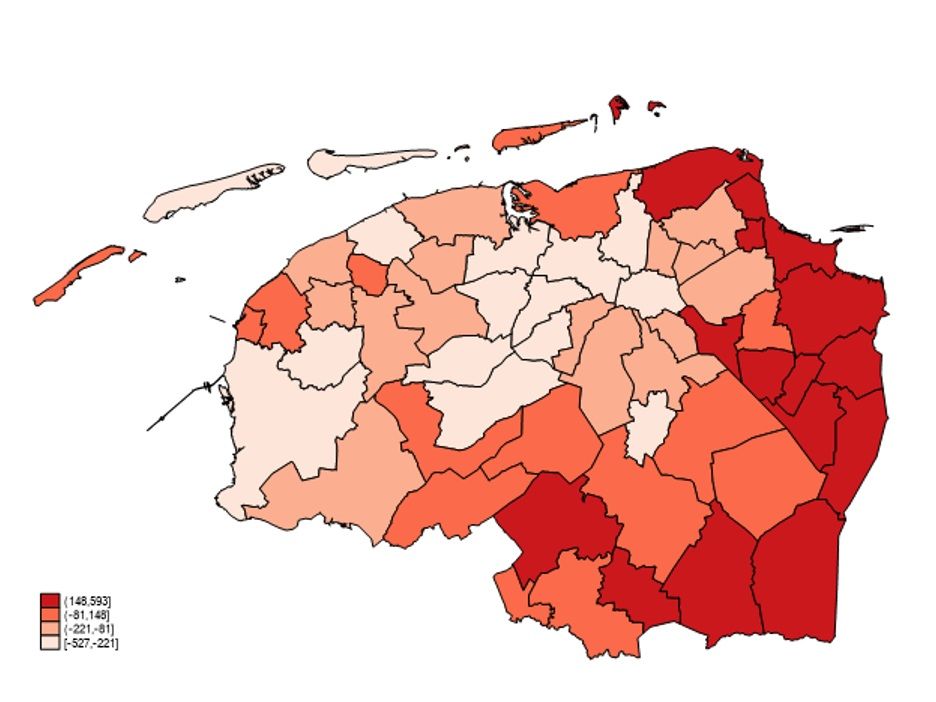Save healthcare costs by comparing neighborhoods - publication in American Journal of Public Health
| Datum: | 21 juni 2019 |

(English version below)
Zorgkosten besparen door wijken te vergelijken
Dat er verschillen zijn in de gezondheid van mensen tussen buurten met hogere en lagere inkomens en opleidingsniveau, dat wisten we al. Maar dat als je erin zou slagen om gezondheidsverschillen tussen buurten met vergelijkbare inkomens- en opleidingsniveaus te verlagen er heel veel zorgkosten kunnen worden bespaard, is nieuw(s). Dit inzicht biedt onder andere aanknopingspunten voor gemeentelijk gezondheidsbeleid gericht op het verbeteren van de gezondheidssituatie in wijken.
Onderzoekers De Boer (Rijksuniversiteit Groningen, Hogeschool Arnhem Nijmegen), Buskens (UMCG), Koning (Rijksuniversiteit Groningen) en Mierau (Rijksuniversiteit Groningen, Aletta Jacobs School of Public Health) bekeken de samenhang tussen zorgkosten en de sociaaleconomische eigenschappen van wijken*. Zij berekenden dat wanneer je die verschillen zou kunnen opheffen er jaarlijks 2,8 miljard aan zorgkosten kan worden bespaard en de gezondheidssituatie in een wijk verbetert. De hoogte van zorgkosten houdt immers verband met de (on)gezondheid van mensen. Het volledig opheffen van sociaaleconomische verschillen, is alleen niet realistisch.
De onderzoekers keken daarom ook naar verschillen in zorguitgaven tussen wijken met een vergelijkbare sociaaleconomische status. Zij zagen eveneens grote verschillen in het uitgavepatroon tussen die wijken. Naar aanleiding van de verschillen tussen sociaaleconomisch gezien vergelijkbare wijken, rekenden de onderzoekers uit dat als elke wijk dezelfde zorguitgaven zou hebben als de gemiddelde wijk met dezelfde sociaaleconomische eigenschappen, er alsnog 1 miljard euro aan zorgkosten te besparen valt.
Deze wetenschap biedt aanknopingspunten om de verschillen tussen sociaaleconomisch vergelijkbare wijken nader te verklaren. Waarom zijn mensen in de ene wijk gemiddeld genomen gezonder en geven zij minder uit aan zorg, dan in de andere? En kunnen we die inzichten gebruiken om bij te dragen aan meer gezondheid en minder zorgkosten in wijken die (nu nog) minder gezond zijn?
De uitkomsten van het onderzoek naar de relatie tussen sociaaleconomische status en zorgkosten is onlangs gepubliceerd in het American Journal of Public Health. https://ajph.aphapublications.org/doi/10.2105/AJPH.2019.305035
Publicatie:
Neighborhood Socioeconomic Status and Health Care Costs: A Population-Wide Study in the Netherlands
Willem I. J. de Boer MSc, Erik Buskens MD, PhD, Ruud H. Koning PhD, and Jochen O. Mierau PhD
*Aanduiding wijkniveau:
Sociaaleconomische status (SES) in wijken op postcode 3 niveau: de onderzoekers hebben in dit onderzoek de relatie onderzocht tussen sociaaleconomische status en zorgkosten op postcode 3 (eerste 3 cijfers) niveau – doorgaans wat groter dan wijkniveau in Nederland. Het is voor het eerst dat dit voor heel Nederland in kaart is gebracht.
Voor meer informatie: Jochen Mierau - j.o.mierau rug.nl
=========================================================
The fact that there are differences in the health of people between neighborhoods with higher and lower incomes and education level is already known. But the fact that if you succeeded in reducing health differences between neighborhoods with comparable income and education levels, a lot of healthcare costs could be saved, is new. Among other things, this insight provides starting points for municipal health policy aimed at improving the health situation in neighborhoods.
Researchers De Boer (University of Groningen, Hogeschool Arnhem Nijmegen), Buskens (UMCG), Koning (University of Groningen) and Mierau (University of Groningen, Aletta Jacobs School of Public Health) examined the relationship between health care costs and the socio-economic properties of neighborhoods*. They calculated that if you could eliminate those differences, 2.8 billion in healthcare costs could be saved each year and the health situation in a neighborhood would improve. The amount of healthcare costs is after all related to the (un)health of people. Complete elimination of socio-economic differences is just not realistic.
The researchers therefore also looked at differences in health care expenditures between neighborhoods with a comparable socio-economic status. They also saw major differences in the spending pattern between those neighborhoods. Following the differences between socially and economically comparable neighborhoods, the researchers calculated that if each neighborhood had the same health care expenditures as the average neighborhood with the same socio-economic characteristics, care costs could still be saved by 1 billion euros.
This knowledge provides starting points for explaining the differences between socio-economically comparable neighborhoods. Why are people in one neighborhood on average healthier and spend less on care than in another? And can we use those insights to contribute to better health and lower healthcare costs in neighborhoods that are (currently) less healthy?
The results of the research on relationship between socio-economic status and health care costs have recently been published in the American Journal of Public Health. https://ajph.aphapublications.org/doi/10.2105/AJPH.2019.305035
Publication:
Neighborhood Socioeconomic Status and Health Care Costs: A Population-Wide Study in the Netherlands
Willem I. J. de Boer MSc, Erik Buskens MD, PhD, Ruud H. Koning PhD, and Jochen O. Mierau PhD
* Indication neighborhood level:Socio-economic status (SES) in neighborhoods at postcode level 3: the researchers investigated in this study the relationship between socio-economic status and health care costs at postcode level 3 (first 3 digits) - usually somewhat higher than neighborhood level in the Netherlands. It is the first time that this has been mapped out for the entire Netherlands.



